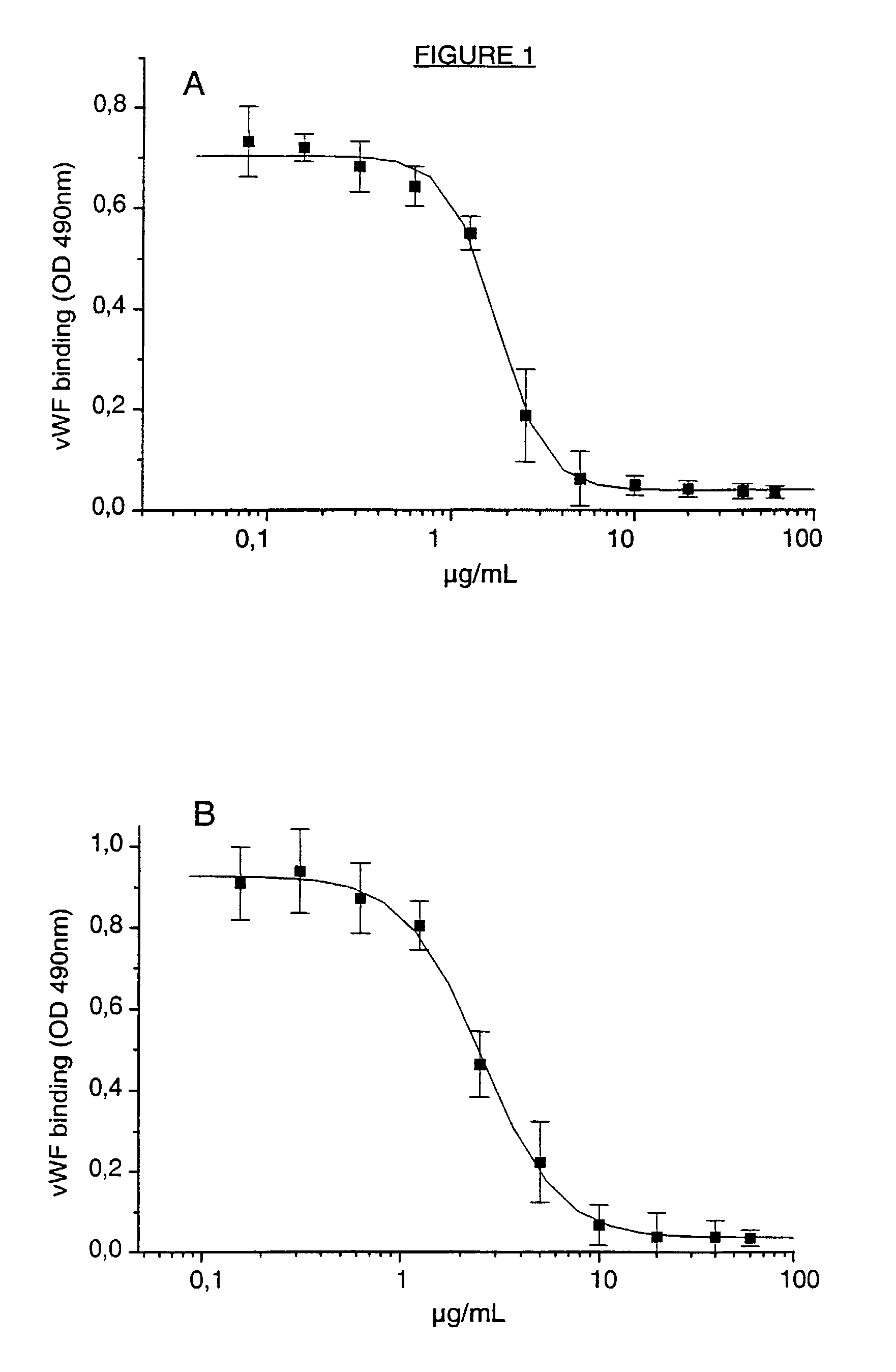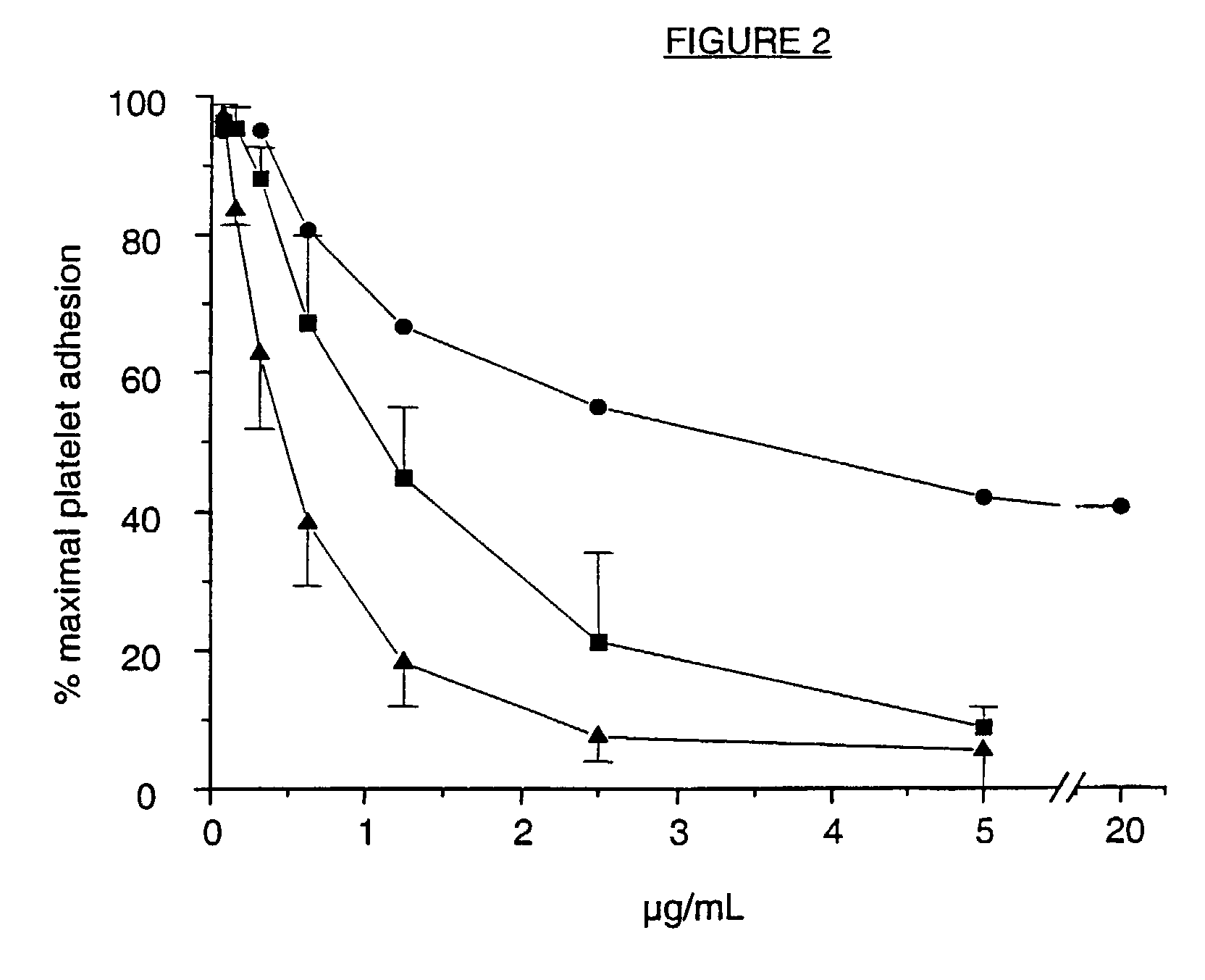Cell lines, ligands and antibody fragments for use in pharmaceutical compositions for preventing and treating haemostasis disorders
a technology of haemostasis and cell lines, applied in the direction of drug compositions, extracellular fluid disorders, antibody medical ingredients, etc., can solve the problems of limited fibrin specificity, large improvement space, and 20% risk of major vascular events, so as to prevent platelet-dependent arterial thrombosis, inhibit binding, and reduce thrombosis. the effect of forming
- Summary
- Abstract
- Description
- Claims
- Application Information
AI Technical Summary
Benefits of technology
Problems solved by technology
Method used
Image
Examples
example 2
r determining deposition of platelets
[0050]Autologous blood platelets were labelled with 111In-tropolone and imaging and quantification of the deposition of 111In-platelets were done as described by Kotze et al., J.Nucl.Med. (1991) 32:62-66. Briefly, image acquisition of the grafts, including proximal and distal silastic segments, was done with a Large Field of View scintillation camera fitted with a high resolution collimator. The images were stored on and analysed with a Medical Data Systems A3 computer (Medtronic, Ann Arbor, Mich.) interfaced with the scintillation camera. Dynamic image acquisition, 2 minute images (128×128 byte mode), was started simultaneously with the start of blood flow through the devices. A two minute image (128×128 byte mode) of a 3 ml autologous blood sample (collected in EDTA) was also acquired each time that the grafts were imaged to determine circulating blood radioactivity (blood standard). A region of interest of the graft segment was selected to det...
example 3
binding measurements
[0051]6B4, its F(ab′)2 or Fab fragments were labelled with Na-125| (Amersham, Buckinghamshire, UK) using the lodogen method as described by Fraker et al., Biochem. Biophys. Res.Comm. (1978) 80:849-857. lodogen was purchased from Pierce (Rockford, Ill.). Platelet-rich baboon plasma, adjusted with autologous plasma to a count of 100,000 platelets / μl, was incubated with different concentrations of iodinated 6B4, F(ab′)2 or Fab fragments for 15 minutes at room temperature. The mixture was layered onto 20% sucrose buffer (wt / vol) containing 0.1% (wt / vol) bovine serum albumin (BSA) and centrifuged for 4 min at 10,000 g in Eppendorf tubes. The top fluid, including the plasma, was removed and the pellets were counted in a gamma-counter. This study was performed in duplicate on the platelet rich plasma of two baboons.
example 4
and ex vivo platelet aggregation measurement
[0052]The aggregation of platelets in response to ristocetin (1.5 mg / ml final concentration; abp, N.Y.) was done on 10 ml blood collected in 1 ml of 3.2% trisodiumcitrate. Platelet rich plasma was prepared by differential centrifugation as described by Van Wyk et al, Thromb.Res. (1990) 57:601-9 and the platelet count adjusted to 200,000 platelets / μl with autologous plasma. The aggregation response was measured in a Monitor IV Plus aggregometer (Helena Laboratories, Beaumont, Tex.) and recorded for 5 minutes. The percent aggregation at 5 minutes was calculated as the difference in light transmission between platelet-rich and platelet-poor plasma.
[0053]In in vitro studies, the platelet rich plasma was preincubated for 5 minutes with serial dilutions of intact IgG 6B4, F(ab′)2 or Fab fragments before aggregation was initiated. Inhibition of aggregation was calculated from the difference in the aggregation response of platelets without and wit...
PUM
| Property | Measurement | Unit |
|---|---|---|
| pH | aaaaa | aaaaa |
| pH | aaaaa | aaaaa |
| temperature | aaaaa | aaaaa |
Abstract
Description
Claims
Application Information
 Login to View More
Login to View More - R&D
- Intellectual Property
- Life Sciences
- Materials
- Tech Scout
- Unparalleled Data Quality
- Higher Quality Content
- 60% Fewer Hallucinations
Browse by: Latest US Patents, China's latest patents, Technical Efficacy Thesaurus, Application Domain, Technology Topic, Popular Technical Reports.
© 2025 PatSnap. All rights reserved.Legal|Privacy policy|Modern Slavery Act Transparency Statement|Sitemap|About US| Contact US: help@patsnap.com



